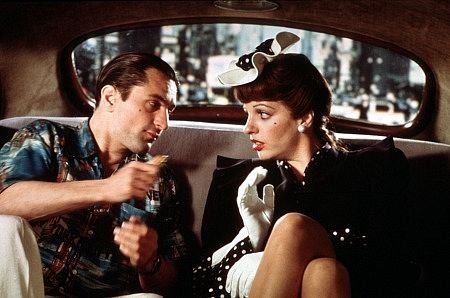
Martin Scorsese’s “New York, New York” is a triumph of just about every quality inherent to cinema. A musical at heart, if not by strict definition, its influence on a much more critically and popularly lauded picture like “La La Land” is abundant in spades. Crafted by a director who is as much a master of melodrama as documentary, of violence as much as the concert film, his portrayal of the famous New York anthem’s genesis is a visual spectacle in the best sense of the term; not as in the attention-deficit-disordered movies dominating today’s marketplace catering to the lowest common denominator, but in the pure sense of a filmmaker’s frame-by-frame, moment-by-moment composition of life, behavior, and musical numbers creating, well – motion.
I don’t know if it was Scorsese’s goal per se, but beyond representing the milieu of the 1940’s, I marveled at how much it truly looked and felt like a color picture of the period in the way Peter Bogdanovich’s “The Last Picture Show” from 1971 remarkably seems like a newly-discovered black and white movie from the 1950’s. That is not an easy feat, evidenced by Steven Soderbergh’s 2006 effort, “The Good German” starring Cate Blanchett, George Clooney, and Toby Maguire, which did not succeed in its stated goal of recreating the look, tone, and feel of a motion picture actually made in the post-war years; this despite Soderbergh shooting it with now-obsolete equipment prevalent in that era.
The issue that I imagine sunk “New York, New York” upon its release in 1977, and apparent at its recent screening at The Metrograph in Manhattan where it will be playing this week through Thursday, is in the writing of Robert De Niro’s character Jimmy Doyle: an A-1, first class, jerk.
The opening scene is an extended set-piece along the lines of the opening wedding reception in Francis Ford Coppola’s 1972 “The Godfather”. A large party and concert with full orchestra celebrating the end of World War II broadcast live on a radio program, its wonderful complexity of elements as a stage on which the rest of the movie is put into motion is realized by a still-young director who manages an about-face of ostensible subject matter after his most recent outing with “Taxi Driver”, which is an apt sequitur to this picture’s problem: Liza Minnelli’s Francine Evans having a love affair with, if not Travis Bickle, certainly Jake LaMotta.
As much as I’m sure an inspiring legend must simply love the pretentiousness of a critic comparing his performance to a previous, more heralded one by an older legend and peer, I wholeheartedly suggest that doing so with Robert De Niro’s Jimmy Doyle and Stanley Kowalski as portrayed by Marlon Brando is apropos of an intrinsic point. The two characters are similarly brutish louts whose female “love” interests would do better by avoiding them, but Vivian Leigh’s Blanch DuBois has just enough time to clutch the pearls around her neck so as to keep her sexual arousal, as well as her feet, planted firmly on the ground at the first sight of Brando’s Stanley entering Elia Kazan’s 1951, “A Streetcar Named Desire”.
By the middle of Francine’s first encounter with Jimmy at a dinner table amidst the opening party in “New York, New York”, the effort to get these two together is already a bit exhausted. His multiple efforts within this scene to get her phone number amount to a miniature set-piece embodying just about everything I imagine a woman is seriously not looking for when she goes out, and it’s laid on thick and serious. Not to say inherent sexual appeal would have smoothed things over (as, frankly, it may be presumed if Minnelli’s character were instead a man being approached my a woman), or that charm should make a man’s repeated and outright refusal to take “no” for answer an easier pill to swallow, but there is not the slightest aspect of Jimmy’s approach that makes the viewer nearly as tolerant of watching it as Francine is to humor it. This is the dead weight holding down the rest of the otherwise beautifully-executed picture, and what could make someone lose sight of the virtuosity of De Niro’s performance of the character as written.
An actor’s performance is an amalgam of so much – an understanding of the text, physical and emotional embodiment of meaning within that text from moment to moment, and, oftentimes, imagination. It’s also possible for an actor’s work to be left hanging out to dry. Regardless of “Streetcar”‘s famous scene of Stanley in torn t-shirt yelling for his wife Stella to come back to him, Brando’s movement and presence of body, per the text as written by Tennessee Williams, is truly epitomized in that first entrance with Blanche – before he even speaks to her, as they lay eyes on each other for the first time; and that is obvious in her immediate, non-verbal reaction to him. Likewise, Stella’s eventual return to Stanley as personified by Kim Hunter, walking slowly down the steps back to him, does its own part to flesh out his sexual appeal to the two women bookending what Brando does with the character himself. Not to champion Stella, nor any one else, going down a potentially wrong path into a toxic relationship, one could forgive a girl’s initial hesitation to turn around and run in the face of the immediate and raw sexuality embodied by her husband both in Brando’s individual portrayal of the character, and his relationship, as written, with her.
As she’s carried home in the arms of her man who moments ago hit her in a drunken, brutish stupor, the now tender, regretful, scared, tearful, and grateful Stanley somberly whispers, “Don’t ever leave me, baby.” Though not fitting the bill as an excuse, this is part of the reason the viewer can more than just stand it, but even exalt in the presumed intensity of the makeup sex about to happen off-screen.
Jimmy’s idea of a wedding proposal to Francine in “New York, New York” is to scream into her face, “I don’t want you to be with anyone else!” until she relents. I could see it working if the whole picture had been a character study of Jimmy, in a similar vein to Joaquin Phoenix’s Arthur Fleck in Todd Phillips’s “Joker”, or in fact, De Niro’s Travis Bickle in Scorsese’s “Taxi Driver” from 1976. There’s a pitch-perfect scene in which Jimmy, struggling to succeed as a saxophone player, in the midst of performing with a full orchestra, shifts into a solo jazz riff at the consternation of the other musicians so as to prevent Francine’s rising star of a singer from getting onstage to perform impromptu at the microphone. But nuance in what might have been a more understandable portrait of Jimmy, or a relationship we might care about, is rare in “New York, New York”.
One imagines it may have been the intent of the movie to explore the inherent difficulties in balancing – or hell, the difficulty in not being eaten alive by – the dynamics of love and commitment in romance at odds with the love and commitment an artist has to his or her own work. But the exploration of something like this does not exist on screen.
In its dual portrait of two musical performers in a romantic relationship, there is just so much one can stand in a central character who, sober, driving with one hand on the wheel, is utterly hell-bent on using the other to beat his pregnant wife in the backseat. If we are supposed to care about this relationship, it just does not work, regardless of what is an underrated performance by De Niro, who, with essentially the same behavior of a man unable to love because of his self-hating jealousy toward the woman in his life, would bless all of cinephelia three years later in “Raging Bull”. Quite a different picture, isn’t it?
ABOUT GIÒ CRISAFULLI:
Giò Crisafulli is writer/director of “Children of God” which he is producing with Melissa Batista at Zio Ciccio Cinema, in which an actor who’s the son of a priest and nun is on the verge of stardom while having an affair with a painter from Italy. A sensational and intuitive look into the romance of two people, it will show how any relationship can be a fleeting microcosm of one’s life.
Check out Giò’s interviews at Lincoln Center’s Opens Roads New Italian Cinema:


